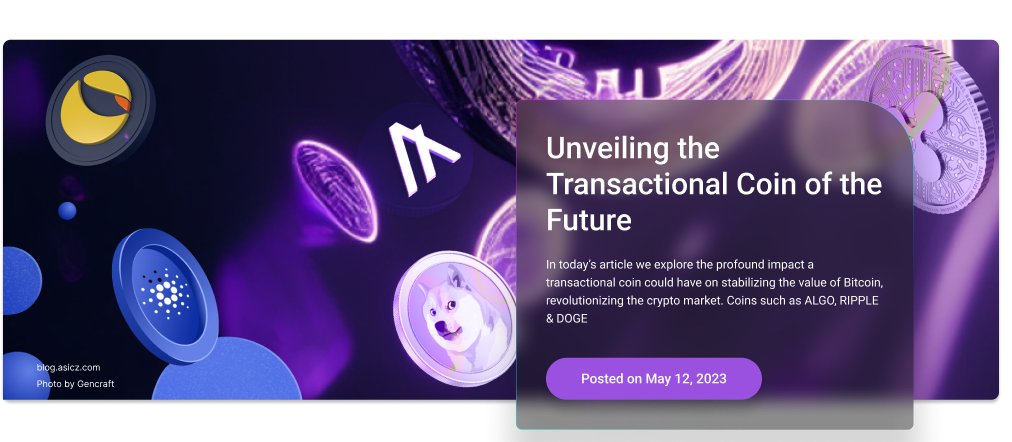Cryptocurrencies have exhibited remarkable potential to revolutionize the financial landscape, with Bitcoin leading the charge as the pioneering digital currency. However, challenges such as volatility and scalability have impeded the widespread adoption of cryptocurrencies for everyday spending. In this Future Friday article, we delve into the realm of possibilities surrounding Algorand, Ripple, Cardano, Luna, and Dogecoin as potential transactional coins, examining the hurdles they must overcome to become universally accepted payment standards. Additionally, we explore the profound impact a transactional coin could have on stabilizing the value of Bitcoin, revolutionizing the crypto market.
Algorand: Scaling New Heights
Algorand emerges as a blockchain platform renowned for its emphasis on scalability, security, and rapid transaction speeds. Its pure proof-of-stake consensus mechanism enables high throughput and low fees. Boasting robust infrastructure, smart contract capabilities, and a developer-friendly ecosystem, Algorand holds significant advantages. However, the challenges of achieving widespread merchant acceptance and establishing brand recognition loom as key obstacles on its path to becoming a transactional coin.
Ripple (XRP): Crossing Borders with Ease
Ripple has carved a niche for itself as a payment protocol designed to facilitate swift, cost-effective cross-border transactions. Its efficient consensus algorithm allows for near-instantaneous settlement times. Ripple’s extensive partnerships with banks and financial institutions amplify its potential as a transactional coin. Nonetheless, regulatory uncertainties and ongoing legal battles present hurdles to Ripple’s wider adoption and merchant acceptance.
Cardano: Building the Future, Layer by Layer
Cardano stands tall as a blockchain platform that prioritizes scientific research, security, and sustainability. With a robust proof-of-stake consensus mechanism and a layered architecture, Cardano aims to deliver scalability and interoperability. Boasting a rigorous development process, peer-reviewed research, and a long-term vision, Cardano carries substantial advantages. However, its journey toward mass adoption necessitates overcoming challenges such as ecosystem expansion and scalability concerns.
Luna (Terra): Rebuilding Trust and Stability as a Transactional Coin
Luna, the native token of the Terra blockchain, was initially recognized for its stability and practicality in day-to-day transactions. As a stablecoin platform, Terra utilized Luna as collateral for stablecoins pegged to various fiat currencies, aiming to provide a reliable and less volatile medium of exchange. However, the significant crash of Luna and UST have raised concerns about its stability and ability to serve as a transactional coin, exposing the inherent risks and challenges in maintaining stability in the cryptocurrency market. Rebuilding trust and confidence among merchants and consumers is now crucial for Luna to regain its position as a widely adopted transactional coin. Despite the recent setback, Luna still offers advantages such as an ardent community of supporters, rapid transactions, and an expanding ecosystem of decentralized applications, which contribute to its practicality and usability. Overcoming the challenges posed by the crash, including implementing risk management measures and enhancing transparency, will be essential.
Dogecoin: From Meme to Mainstream?
Dogecoin, born from lighthearted origins, has captivated a broad audience and fostered a passionate community. Swift transaction speeds and low fees form the backbone of its appeal. Recognition and acceptance by various merchants, including major companies, bolster Dogecoin’s potential as a transactional coin. Additionally, recent discussions have emerged regarding Elon Musk potentially considering the use of Dogecoin as a transactional currency on the Twitter platform, further enhancing its visibility and prospects. However, its lack of advanced features, scalability concerns, and potential regulatory obstacles still present challenges to its long-term viability.
Impact on Bitcoin’s Value: Redefining Stability
The emergence of a transactional coin with widespread adoption and stability possesses the power to redefine Bitcoin’s value proposition. Bitcoin’s volatility stems from its speculative nature and limited use as a medium of exchange. However, the introduction of a widely accepted transactional coin could instill confidence in cryptocurrencies for everyday transactions, reducing Bitcoin’s price volatility, stabilizing its value, and positioning it as a reliable store of value beyond a speculative asset.
Forging the Path Ahead
While the journey towards a transactional coin for everyday spending is filled with challenges, the possibilities offered by Algorand, Ripple, Cardano, Luna, Dogecoin, and other contenders are promising. Overcoming hurdles and achieving widespread adoption will pave the way for a transformative future, where cryptocurrencies become seamlessly integrated into our daily lives as a standard medium of exchange. With each passing day, we inch closer to the realization of this vision, and the impact on the value of Bitcoin and the broader crypto market will undoubtedly be profound.
For those seeking to delve further, AsicZ is a valuable resource. As a trusted provider of volume mining hardware and competitive hosting solutions, AsicZ empowers individuals and businesses to participate in the exciting realm of Bitcoin mining. With their years of experience and expertise navigating all market conditions, AsicZ enables crypto enthusiasts to mine profitably and sustainably while actively contributing to the decentralized revolution.

